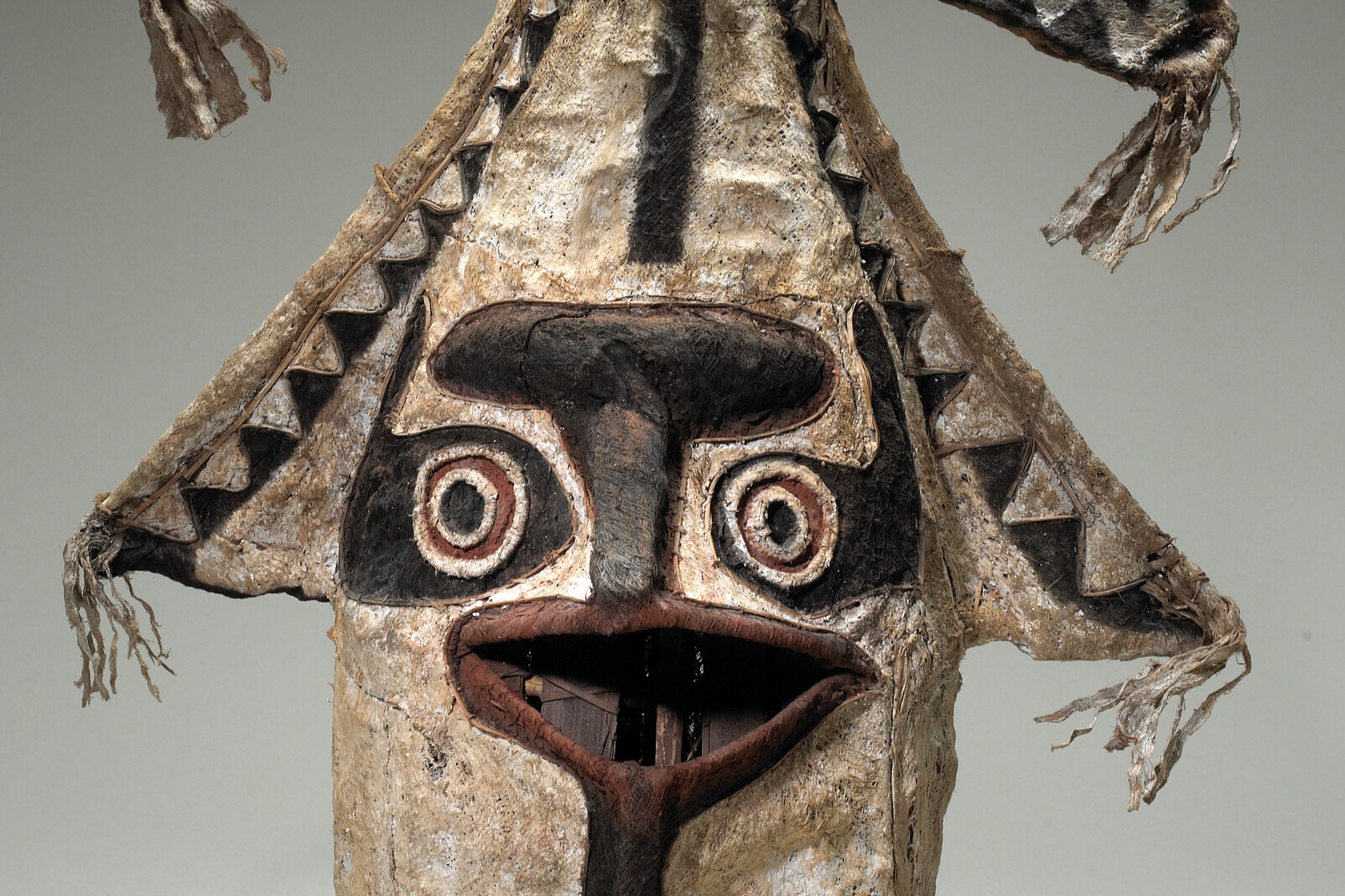
“Thing of Gladness”: Eharo Dance Mask
By Rob Bedeaux
May 9, 2025—Societies have used art to represent myths, religion, and traditions for eons. In Europe, the Book of Kells, an early Christian illuminated manuscript, contains pre-Christian decorative elements and abstract symbols that represent lost or suppressed pagan traditions. In Africa, the Nok terra-cotta figures likely depict spiritual practices, but the oral traditions and cultural framework that once explained them have not survived. And in the Americas, the Olmec colossal heads probably represent rulers or revered ancestors—though richly symbolic, the Olmec left no deciphered writing.
In Oceania, the Western Elema people of Papua New Guinea created Eharo dance masks as part of their Hevehe cycle of ceremonies. But the history behind the Hevehe cycle and the details of the lineage of these masks have been lost.
Hevehe Cycle

During American Asian and Pacific Islander Heritage month, you can see an example of an Eharo dance mask in Mia’s lobby.
The Hevehe cycle was an amalgamation of ceremonies practiced by the Western Elema men of Orokolo in Papua New Guinea. The scholars who documented the cycle in the early 20th century never uncovered the source of the cycle. That said, firsthand accounts noted that it appeared to have a carnivalesque feel, and while many of the practices paid homage to local animistic deities, others were purely for entertainment.
The cycle began with the construction of a new eravo (men’s house) and then continued during four distinct ceremonial phases: Creation of Hevehe Masks, Ceremonies of the New Door, the Descents, and the Ritual Destruction. The entire cycle lasted from seven to 10 years.
Construction
The eravo was a sacred men’s house serving as the central venue for ritual activities. Its construction was a communal effort, symbolizing the unity and cooperation of the community. The phase typically took one to two years.
Creation of Hevehe Masks
Hevehe was inextricably tied to the two types of masks—the apa-hevehe (tall drum mask) and the eharo (dance headpiece).
This phase opened with the ceremonial cleaving of the coconut and cutting of the first canes for the mask. These materials were then used to construct the first pair of fantastical apa-hevehe masks. These masks could be up to 18 feet (six meters) tall and were constructed of local, native plants (bark cloth, bast fiber, sago leaf, and other materials). Each construction step and material was celebrated by rituals and feasting.
After the first cleaving and cutting, the rough masks were brought into the eravo, where the village’s women would finish them out of sight , only to reappear for their ceremonial uses.
Ceremony of the New Door
The Ceremony of the New Door marked the transition from the construction of the masks to ritual practices.
During this ceremony, performers donned eharo masks like the one at Mia—lighthearted and comical creations symbolizing spirits or totemic beings. Local villagers didn’t create these masks; rather, young men from neighboring villages invited to the festival would make them and wear them in the ceremony.
Public Display and Masquerade
After the Ceremony of the New Door, a month of celebrations began. During this time, the apa-hevehe masks were brought out for a public masquerade. This period involved dances and rituals aimed at appeasing the spirits and celebrating communal unity.
Ritual Destruction
At the end of the masquerade, the masks were ceremonially burned, symbolizing the release of the spirits and the cycle’s conclusion. This act also signified the community’s readiness to commence a new cycle.
The Role of the Eharo Mask
The eharo masks were primarily used during the Ceremony of the New Door. Young men from other villages were invited to the ceremony and would arrive wearing eraho they had created. As the young men entered the host village, the resident women pelted them with shredded coconut to neutralize their seductive powers, which might otherwise prove irresistible to the village daughters. The men wearing the eharo masks then danced, leaping through the air. Some dancers were allowed to enter the eravo and left their masks inside. Those not selected returned home with their masks.
This part of the cycle was considered maea morava eharu, or a “thing of gladness,” and provided a light, humorous break during the more serious portions of the ceremonies.

Left: Totem fish mask, Orokolo Bay area of New Guinea. Painted bark cloth over rattan frame with fringe of dried grass. Right: Eharo mask, Papua New Guinea. Cane, pith, bark cloth, natural pigment. Australian Museum.
Most masks were constructed by covering a cane framework with bark cloth and coconut fiber (pith). They were typically painted with red, black, and white pigment derived from natural materials like clay, chalk, and soot. Oftentimes, a thick fringe of fiber would have hung down from the base of the mask and covered the shoulders and upper torso of the wearer. Many masks were topped with a creature that had spiritual significance, such as an insect, bird, fish, tree, or even a mushroom or jellyfish. Others were improvised and purely fanciful.
Like most Elema art, the masks focused on the human form, particularly faces. Faces were depicted with wide eyes and rows of pointed teeth. These designs mimicked traditional war decorations. If used, animals, fish, plants, and celestial forms would have been subordinated to the human elements.

Eharo dance mask without totemic model. For the dance, it would be trimmed around the edges with feathers. (Williams, F. E., Drama of Orokolo: The Social and Ceremonial Life of the Elema. London: Oxford University Press, Humphrey Milford, 1940.)
